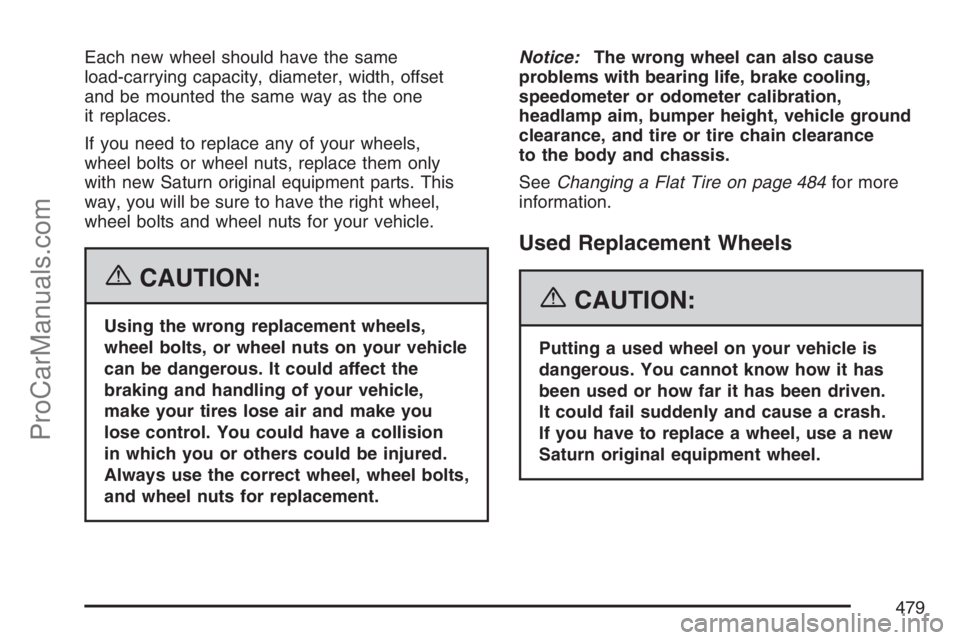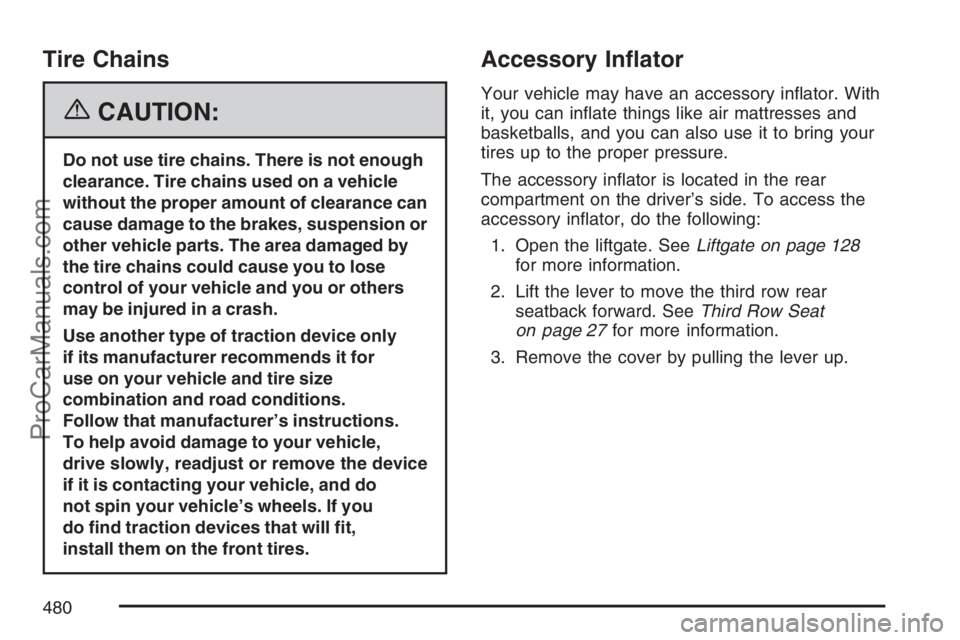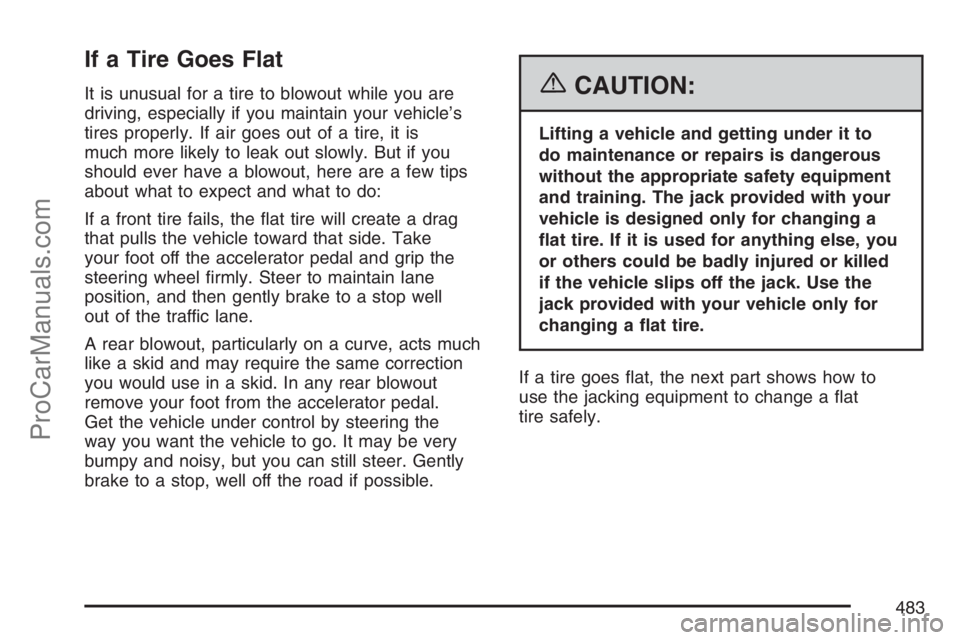wheel SATURN RELAY 2007 Workshop Manual
[x] Cancel search | Manufacturer: SATURN, Model Year: 2007, Model line: RELAY, Model: SATURN RELAY 2007Pages: 570, PDF Size: 3.41 MB
Page 475 of 570

{CAUTION:
Mixing tires could cause you to lose
control while driving. If you mix tires of
different sizes, brands, or types (radial
and bias-belted tires), the vehicle may
not handle properly, and you could have
a crash. Using tires of different sizes,
brands, or types may also cause damage
to your vehicle. Be sure to use the
correct size, brand, and type of tires on
all wheels. It is all right to drive with
your compact spare temporarily, as it
was developed for use on your vehicle.
SeeCompact Spare Tire on page 500.
{CAUTION:
If you use bias-ply tires on your vehicle,
the wheel rim �anges could develop
cracks after many miles of driving. A tire
and/or wheel could fail suddenly, causing
a crash. Use only radial-ply tires with the
wheels on your vehicle.
If you must replace your vehicle’s tires with
those that do not have a TPC Spec number,
make sure they are the same size, load range,
speed rating, and construction type (radial
and bias-belted tires) as your vehicle’s
original tires.
Your vehicle’s original equipment tires are listed
on the Tire and Loading Information Label.
This label is attached to the vehicle’s center pillar
(B-pillar). SeeLoading Your Vehicle on page 391,
for more information about the Tire and Loading
Information Label and its location on your vehicle.
475
ProCarManuals.com
Page 476 of 570

Different Size Tires and Wheels
If you add wheels or tires that are a different size
than your original equipment wheels and tires,
this may affect the way your vehicle performs,
including its braking, ride and handling
characteristics, stability, and resistance to rollover.
Additionally, if your vehicle has electronic
systems such as, anti-lock brakes, traction control,
and stability control, the performance of these
systems can be affected.{CAUTION:
If you add different sized wheels, your
vehicle may not provide an acceptable
level of performance and safety if tires
not recommended for those wheels are
selected. You may increase the chance that
you will crash and suffer serious injury.
Only use Saturn speci�c wheel and tire
systems developed for your vehicle, and
have them properly installed by a Saturn
certi�ed technician.
SeeBuying New Tires on page 474and
Accessories and Modi�cations on page 412for
additional information.
476
ProCarManuals.com
Page 478 of 570

Temperature – A, B, C
The temperature grades are A (the highest),
B, and C, representing the tire’s resistance to
the generation of heat and its ability to dissipate
heat when tested under controlled conditions on a
speci�ed indoor laboratory test wheel. Sustained
high temperature can cause the material of the tire
to degenerate and reduce tire life, and excessive
temperature can lead to sudden tire failure.
The grade C corresponds to a level of performance
which all passenger car tires must meet under
the Federal Motor Vehicle Safety Standard
No. 109. Grades B and A represent higher levels
of performance on the laboratory test wheel
than the minimum required by law.
Warning:The temperature grade for this tire is
established for a tire that is properly in�ated
and not overloaded. Excessive speed,
underin�ation, or excessive loading, either
separately or in combination, can cause heat
buildup and possible tire failure.
Wheel Alignment and Tire Balance
The tires and wheels on your vehicle were aligned
and balanced carefully at the factory to give you
the longest tire life and best overall performance.
Adjustments to wheel alignment and tire
balancing will not be necessary on a regular basis.
However, if you notice unusual tire wear or your
vehicle pulling to one side or the other, the
alignment may need to be checked. If you notice
your vehicle vibrating when driving on a smooth
road, your tires and wheels may need to be
rebalanced. See your retailer for proper diagnosis.
Wheel Replacement
Replace any wheel that is bent, cracked or badly
rusted or corroded. If wheel nuts keep coming
loose, the wheel, wheel bolts and wheel nuts
should be replaced. If the wheel leaks air, replace
it (except some aluminum wheels, which can
sometimes be repaired). See your retailer if any of
these conditions exist.
Your retailer will know the kind of wheel you need.
478
ProCarManuals.com
Page 479 of 570

Each new wheel should have the same
load-carrying capacity, diameter, width, offset
and be mounted the same way as the one
it replaces.
If you need to replace any of your wheels,
wheel bolts or wheel nuts, replace them only
with new Saturn original equipment parts. This
way, you will be sure to have the right wheel,
wheel bolts and wheel nuts for your vehicle.
{CAUTION:
Using the wrong replacement wheels,
wheel bolts, or wheel nuts on your vehicle
can be dangerous. It could affect the
braking and handling of your vehicle,
make your tires lose air and make you
lose control. You could have a collision
in which you or others could be injured.
Always use the correct wheel, wheel bolts,
and wheel nuts for replacement.Notice:The wrong wheel can also cause
problems with bearing life, brake cooling,
speedometer or odometer calibration,
headlamp aim, bumper height, vehicle ground
clearance, and tire or tire chain clearance
to the body and chassis.
SeeChanging a Flat Tire on page 484for more
information.
Used Replacement Wheels
{CAUTION:
Putting a used wheel on your vehicle is
dangerous. You cannot know how it has
been used or how far it has been driven.
It could fail suddenly and cause a crash.
If you have to replace a wheel, use a new
Saturn original equipment wheel.
479
ProCarManuals.com
Page 480 of 570

Tire Chains
{CAUTION:
Do not use tire chains. There is not enough
clearance. Tire chains used on a vehicle
without the proper amount of clearance can
cause damage to the brakes, suspension or
other vehicle parts. The area damaged by
the tire chains could cause you to lose
control of your vehicle and you or others
may be injured in a crash.
Use another type of traction device only
if its manufacturer recommends it for
use on your vehicle and tire size
combination and road conditions.
Follow that manufacturer’s instructions.
To help avoid damage to your vehicle,
drive slowly, readjust or remove the device
if it is contacting your vehicle, and do
not spin your vehicle’s wheels. If you
do �nd traction devices that will �t,
install them on the front tires.
Accessory In�ator
Your vehicle may have an accessory in�ator. With
it, you can in�ate things like air mattresses and
basketballs, and you can also use it to bring your
tires up to the proper pressure.
The accessory in�ator is located in the rear
compartment on the driver’s side. To access the
accessory in�ator, do the following:
1. Open the liftgate. SeeLiftgate on page 128
for more information.
2. Lift the lever to move the third row rear
seatback forward. SeeThird Row Seat
on page 27for more information.
3. Remove the cover by pulling the lever up.
480
ProCarManuals.com
Page 483 of 570

If a Tire Goes Flat
It is unusual for a tire to blowout while you are
driving, especially if you maintain your vehicle’s
tires properly. If air goes out of a tire, it is
much more likely to leak out slowly. But if you
should ever have a blowout, here are a few tips
about what to expect and what to do:
If a front tire fails, the �at tire will create a drag
that pulls the vehicle toward that side. Take
your foot off the accelerator pedal and grip the
steering wheel �rmly. Steer to maintain lane
position, and then gently brake to a stop well
out of the traffic lane.
A rear blowout, particularly on a curve, acts much
like a skid and may require the same correction
you would use in a skid. In any rear blowout
remove your foot from the accelerator pedal.
Get the vehicle under control by steering the
way you want the vehicle to go. It may be very
bumpy and noisy, but you can still steer. Gently
brake to a stop, well off the road if possible.{CAUTION:
Lifting a vehicle and getting under it to
do maintenance or repairs is dangerous
without the appropriate safety equipment
and training. The jack provided with your
vehicle is designed only for changing a
�at tire. If it is used for anything else, you
or others could be badly injured or killed
if the vehicle slips off the jack. Use the
jack provided with your vehicle only for
changing a �at tire.
If a tire goes �at, the next part shows how to
use the jacking equipment to change a �at
tire safely.
483
ProCarManuals.com
Page 484 of 570

Changing a Flat Tire
If a tire goes �at, avoid further tire and wheel
damage by driving slowly to a level place.
Turn on your vehicle’s hazard warning �ashers.
SeeHazard Warning Flashers on page 182
for more information.{CAUTION:
Changing a tire can be dangerous. The
vehicle can slip off the jack and roll over
or fall on you or other people. You and
they could be badly injured or even killed.
Find a level place to change your tire.
To help prevent the vehicle from moving:
1. Set the parking brake �rmly.
2. Put the shift lever in PARK (P).
3. Turn off the engine and do not restart
while the vehicle is raised.
4. Do not allow passengers to remain
in the vehicle.
To be even more certain the vehicle will
not move, you should put blocks at the
front and rear of the tire farthest away
from the one being changed. That would
be the tire, on the other side, at the
opposite end of the vehicle.
484
ProCarManuals.com
Page 485 of 570

When your vehicle has a �at tire, use the following
example as a guide to assist you in the placement
of wheel blocks.
The following information will tell you next how to
use the jack and change a tire.Removing the Spare Tire and Tools
The tools needed to remove the spare tire are
located in the storage compartment at the rear of
the vehicle, on the passenger’s side.
To remove the tools, do the following:
1. Open the liftgate. SeeLiftgate on page 128
for more information.
2. Remove the convenience net, if the vehicle
has one.
485
ProCarManuals.com
Page 487 of 570

To remove the compact spare tire, do the following:
A. Hoist Shaft
B. Hoist Assembly
C. Retainer
D. Compact Spare TireE. Extension
(Chisel End)
F. Folding Wrench
1. Attach the folding wrench (F) to the
extension (E) and insert the chisel end on
an angle through the hole in the rear bumper
and into the hoist shaft (A).2. Turn the folding wrench counterclockwise to
lower the compact spare tire (D) to the
ground. Continue to turn the wrench so the
compact spare tire can be pulled out from
under the vehicle.
3. Tilt the retainer at the end of the cable to
remove the compact spare tire, so it can
be pulled up through the wheel opening.
The hoist is used to store a full-size or a �at
road tire under the vehicle. SeeStoring a
Flat or Spare Tire and Tools on page 497
for more information.
4. Remove the compact spare tire from the cable.
487
ProCarManuals.com
Page 488 of 570

If the compact spare tire will not lower, check
under the vehicle to see if the tire is hanging
loose and the cable end and spring under
the wheel plate are missing. If so, the secondary
latch system is engaged. SeeSecondary Latch
System on page 495.
To continue changing the �at tire, see
Removing the Flat Tire and Installing the
Spare Tire on page 488.Removing the Flat Tire and
Installing the Spare Tire
Your vehicle may have aluminum wheels. If so,
you will see exposed stainless steel wheel
nuts. Use the wheel wrench to loosen all of the
wheel nuts. Do not remove them yet. Or, your
vehicle may have steel wheel covers. To remove
the wheel covers and wheel nut caps, loosen
the plastic nut caps with the wheel wrench in a
counterclockwise direction. If needed, you
can �nish loosening with your �ngers. The plastic
nut caps will not come off. Use the �at end of
the wheel wrench and pry along the edge of the
cover until it comes off. The edge of the wheel
cover could be sharp, so do not try to remove it
with your bare hands. Do not drop the cover or lay
it face down, as it could become scratched or
damaged. Once you have removed the wheel
cover, use the following procedure to remove the
�at tire and install the spare tire.
488
ProCarManuals.com